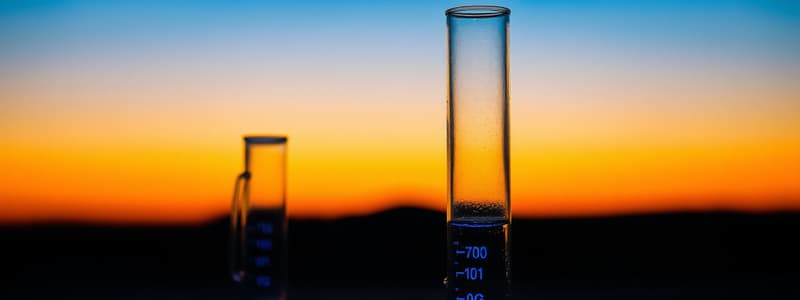Podcast
Questions and Answers
What effect does a non-competitive inhibitor have on the reaction rate?
What effect does a non-competitive inhibitor have on the reaction rate?
- It has no effect on the reaction rate or the affinity of the substrate.
- It affects both the reaction rate and the substrate affinity.
- It decreases the reaction rate without affecting the affinity of the substrate for the enzyme. (correct)
- It increases the reaction rate by stabilizing the enzyme-substrate complex.
How do competitive inhibitors impact the Km value?
How do competitive inhibitors impact the Km value?
- They lower the Km value, increasing substrate affinity.
- They have no effect on the Km value.
- They raise the Km value, decreasing substrate affinity. (correct)
- They decrease the Vmax value without altering the Km value.
In which scenario can an inhibitor bind to an enzyme?
In which scenario can an inhibitor bind to an enzyme?
- When the enzyme has undergone conformational change.
- Only when the enzyme is free and unbound.
- When the enzyme is either free or bound to the substrate. (correct)
- Only when the substrate is already bound to the enzyme.
What is the impact of allosteric inhibition on the active site?
What is the impact of allosteric inhibition on the active site?
What characterizes the binding of a competitive inhibitor compared to a non-competitive inhibitor?
What characterizes the binding of a competitive inhibitor compared to a non-competitive inhibitor?
What is the primary function of an active site in an enzyme?
What is the primary function of an active site in an enzyme?
Which of the following statements is true about vitamins in relation to energy metabolism?
Which of the following statements is true about vitamins in relation to energy metabolism?
Which of the following best describes a holoenzyme?
Which of the following best describes a holoenzyme?
What characterizes the specificity of an active site?
What characterizes the specificity of an active site?
Which process is NOT associated with the function of the active site?
Which process is NOT associated with the function of the active site?
Which vitamin acts as a coenzyme involved in the metabolism of amino acids and nucleic acids?
Which vitamin acts as a coenzyme involved in the metabolism of amino acids and nucleic acids?
In the context of enzymatic reactions, what does 'dehydrogenation' refer to?
In the context of enzymatic reactions, what does 'dehydrogenation' refer to?
Which of the following is a consequence of the active site’s specific binding?
Which of the following is a consequence of the active site’s specific binding?
What role do cofactors play in enzyme function?
What role do cofactors play in enzyme function?
What distinguishes glucose as a substrate for certain enzymes?
What distinguishes glucose as a substrate for certain enzymes?
What characterizes an endergonic reaction based on free energy levels?
What characterizes an endergonic reaction based on free energy levels?
What does a negative value of ∆G indicate about a reaction?
What does a negative value of ∆G indicate about a reaction?
In the equation ∆G = ∆H - T∆S, which component represents the internal energy of the system?
In the equation ∆G = ∆H - T∆S, which component represents the internal energy of the system?
Why is the downhill movement of a ball considered spontaneous?
Why is the downhill movement of a ball considered spontaneous?
What is true when ∆G equals zero?
What is true when ∆G equals zero?
What typically happens to the free energy of reactants in exergonic reactions?
What typically happens to the free energy of reactants in exergonic reactions?
Which of the following statements about entropy (∆S) is correct?
Which of the following statements about entropy (∆S) is correct?
What factor differentiates an endergonic reaction from an exergonic reaction?
What factor differentiates an endergonic reaction from an exergonic reaction?
What happens to the kinetic energy of molecules when the temperature increases?
What happens to the kinetic energy of molecules when the temperature increases?
Which of the following illustrates the role of catalysts in chemical reactions?
Which of the following illustrates the role of catalysts in chemical reactions?
What is the first step in the enzymatic reaction process?
What is the first step in the enzymatic reaction process?
How does the presence of a catalyst affect the activation energy of a reaction?
How does the presence of a catalyst affect the activation energy of a reaction?
During which step of the enzymatic process does bond formation occur?
During which step of the enzymatic process does bond formation occur?
What signifies the molar concentration in a chemical reaction?
What signifies the molar concentration in a chemical reaction?
What is the correct sequence of steps in the enzymatic reaction process?
What is the correct sequence of steps in the enzymatic reaction process?
In the context of enzymes, what does the term 'activation energy' refer to?
In the context of enzymes, what does the term 'activation energy' refer to?
What results from the collision of substrate molecules in a chemical reaction?
What results from the collision of substrate molecules in a chemical reaction?
What effect does a catalyst have on the rate of a chemical reaction?
What effect does a catalyst have on the rate of a chemical reaction?
Which type of reaction is characterized by the release of heat and can also be referred to as exothermic?
Which type of reaction is characterized by the release of heat and can also be referred to as exothermic?
What effect does increasing the concentration of reactants have on a chemical reaction?
What effect does increasing the concentration of reactants have on a chemical reaction?
Which of the following is NOT a factor that affects reaction rates?
Which of the following is NOT a factor that affects reaction rates?
What does the equilibrium constant indicate in a chemical reaction?
What does the equilibrium constant indicate in a chemical reaction?
Which statement about endergonic reactions is true?
Which statement about endergonic reactions is true?
How does temperature generally impact the rates of chemical reactions?
How does temperature generally impact the rates of chemical reactions?
Which mechanism most directly contributes to the increased product formation as reactant concentration rises?
Which mechanism most directly contributes to the increased product formation as reactant concentration rises?
Under what condition would the formation of reactants be favored based on equilibrium concepts?
Under what condition would the formation of reactants be favored based on equilibrium concepts?
If the temperature of a reaction is decreased, what is the expected outcome on the reaction rate?
If the temperature of a reaction is decreased, what is the expected outcome on the reaction rate?
What is the primary role of catalysts in chemical reactions?
What is the primary role of catalysts in chemical reactions?
Flashcards are hidden until you start studying
Study Notes
Free Energy Concepts
- Free energy (∆G): Portion of total energy in a system available for work.
- Endergonic reactions occur when products have higher free energy than reactants (∆G > 0).
- Exergonic reactions occur when reactants have higher free energy than products (∆G < 0).
- At equilibrium (∆G = 0), no net change occurs in the system.
Reaction Types
-
Exergonic Reactions:
- Also termed exothermic; energy is released as heat.
- Spontaneous with a negative ∆G.
- Example: Downhill movement of a ball (higher energy to lower energy).
-
Endergonic Reactions:
- Also termed endothermic; need input of energy for reactions to proceed.
- Nonspontaneous with a positive ∆G.
Equilibrium and Reaction Rates
- Equilibrium constant defines the ratio of concentrations of products to reactants.
- The constant indicates if a reaction favors product formation (forwards) or reactant formation (backwards).
Factors Affecting Reaction Rates
- Temperature: Higher temperature increases molecular movement and reaction rates.
- Reactant Concentration: Increasing substrate concentration leads to more collisions and increased product formation.
- Catalysts: Enzymes speed up reactions by lowering activation energy, enhancing the rate of reactants being converted into products.
Enzyme Action and Mechanism
- Enzymes bind to substrates at the active site, forming an enzyme-substrate complex.
- Key steps include:
- Substrate binding.
- Formation of the product through catalytic actions like bond formation/breaking.
- Product detachment from the enzyme.
Enzyme Specificity and Inhibition
-
Active sites of enzymes are specific to certain substrates, facilitating specific reactions.
-
Competitive Inhibitors:
- Bind to the active site, competing with the substrate.
- Decrease enzyme affinity for the substrate without affecting the overall reaction maximum velocity (Vmax).
-
Allosteric Inhibitors:
- Bind to allosteric sites, causing conformational changes that inhibit substrate binding to the active site.
- Can bind to free enzymes or those with substrate already attached, resulting in inactive complexes.
Vitamins and Coenzymes
- Vitamins such as ascorbic acid and folic acid act as coenzymes, aiding in metabolic reactions without providing energy directly.
- Holoenzymes refer to the complete form of an enzyme, including its protein portion and any necessary cofactors.
Studying That Suits You
Use AI to generate personalized quizzes and flashcards to suit your learning preferences.



